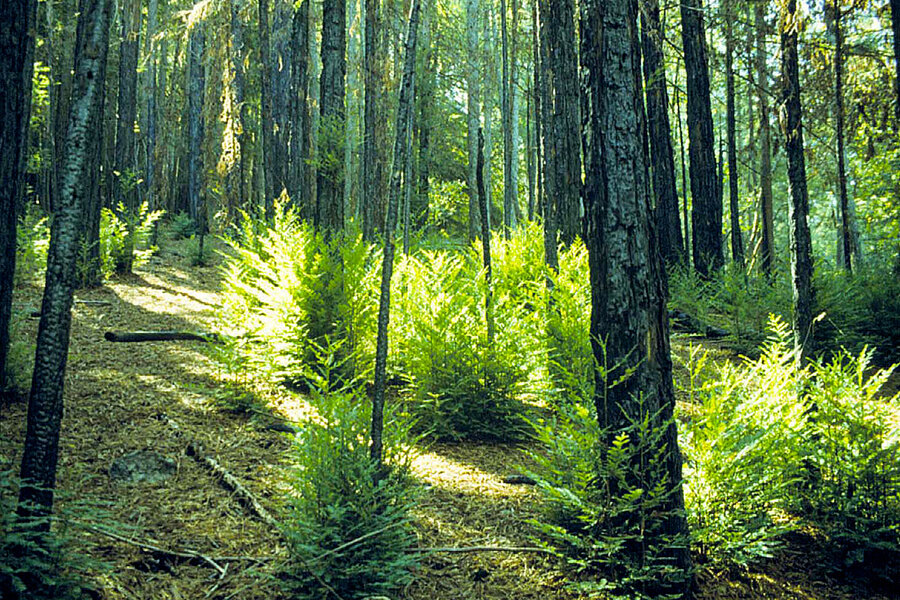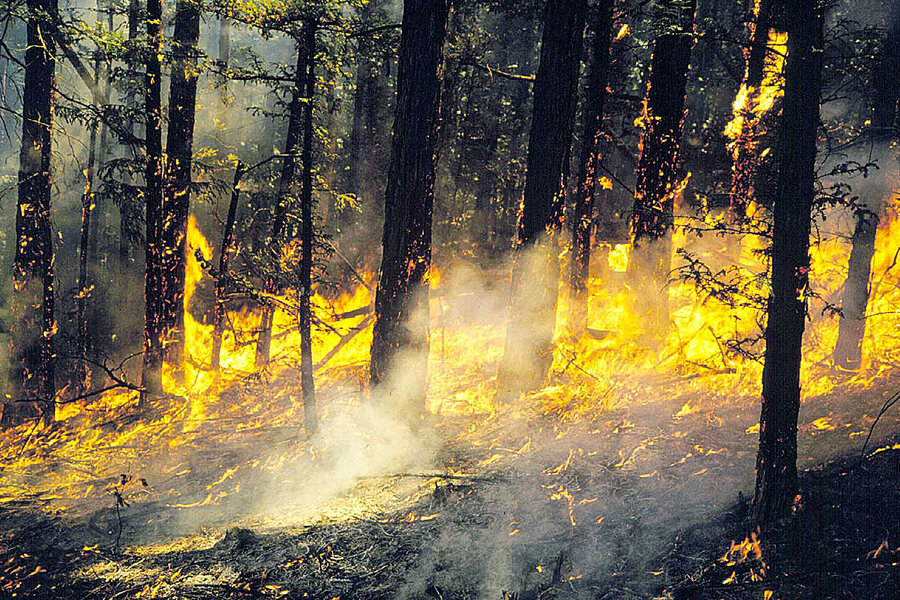‘We’re not dead yet’: Big Basin redwoods scorched, but not lost.
Loading...
| Pasadena, Calif.
The news was heartbreaking. California’s oldest state park, home to coast redwood trees as tall as skyscrapers and dating back to the Roman Empire, suffered extensive damage in this month’s massive fires.
A pang of sorrow rippled across the United States, as Americans faced the possibility that one of the nation’s most beloved natural treasures could be gone forever. But despite the apparent devastation, most of the redwood conifers are not actually dead, say scientists.
Why We Wrote This
A story focused onResilience can be hard to muster in the face of devastation. In Big Basin State Park, California’s beloved redwoods offer a lesson in hope and rebirth.
The trees of Big Basin Redwoods State Park “will very quickly recover,” says Mark Finney, a research forester at the U.S. Forest Service’s Fire Sciences Laboratory in Missoula, Montana. He’s seen it happen before.
As a graduate student, Dr. Finney took part in prescribed burnings to see how coast redwoods would react under different fire circumstances. “It was really surprising,” he says, “but pretty much all of the trees came back with a flush of green growth within months.”
By spring, he says, the redwoods of Big Basin will already be showing signs of rebirth. “Within three or four years,” he says, “the redwoods will look completely normal.”
The news was heartbreaking. California’s oldest state park, home to coast redwood trees as tall as skyscrapers and dating back to the Roman Empire, suffered extensive damage in this month’s massive fires.
Big Basin Redwoods State Park, as it has been known and loved for generations, “is gone,” reported the Sempervirens Fund, a redwood conservancy that helped found the park in 1902. “We feel like we have lost an old friend.”
That sorrow rippled across the United States, as Americans faced the possibility that one of the country’s most beloved natural treasures could be gone forever, one more tragedy in a year filled with turmoil, uncertainty, and loss. But despite the apparent devastation, most of the redwood conifers are not actually dead, say scientists. These Sequoia sempervirens, or “ever-living sequoia,” have endured for centuries. And this spring, they will undoubtedly sprout mini-trees around their bases and start to leaf out. The blackened sentinels, towering in the park about 45 miles south of San Francisco, “will very quickly recover,” says Mark Finney, a research forester at the U.S. Forest Service’s Fire Sciences Laboratory in Missoula, Montana.
Why We Wrote This
A story focused onResilience can be hard to muster in the face of devastation. In Big Basin State Park, California’s beloved redwoods offer a lesson in hope and rebirth.
In an interview with the Monitor, Dr. Finney explains why these trees are so resilient and what this 18,000-acre park cascading down the mountains toward the Pacific Ocean will soon look like. It’s something he’s seen before. Or close to it.
About 30 years ago, when he was a graduate student in forestry at the University of California, Berkeley, he took part in prescribed burnings of coast redwoods with California’s Department of Parks and Recreation. The goal was to see how the redwoods would react under different fire circumstances.
The burnings were “somewhat controversial” because redwoods are an “emotional issue,” given their near wipeout by lumber mills after the gold rush, and their incredible size and longevity. They are the tallest trees on Earth and some are more than 2,000 years old. The trees grow only along the coast of California, with a toehold in Oregon, though fossils that go back millions of years can be found around the world.
The burns were conducted in 1989 and 1990 on plots of “young growth” forest – trees that were 150 years or newer – in two state parks north of San Francisco, in Humboldt and Sonoma counties. They tested for varying fuel consumption and fire intensity by burning in the spring and fall, and setting fires upslope with the wind, and downslope against it.
“It was really surprising,” says Dr. Finney. Under the most severe conditions, all the foliage was killed, the needles turned brown, and the trunks were scorched almost to the top. “But pretty much all of the trees came back with a flush of green growth within months,” he says. “They basically just didn’t die.”
Most conifers do not sprout back when traumatized, but redwoods have “remarkable sprouting ability,” says Dr. Finney. Each tree is wrapped in a thick, insulating bark – several feet thick in old-growth groves such as in Big Basin. Beneath the bark lie buds that remain dormant until activated by some trauma – lightning, fire, or wind. The trees are also genetically built to resist rot, and are remarkably free from fatal enemies like fungus, defoliators, and bark beetles. And they grow extremely quickly.
“These forests are going to come through so much better than any of the fires of the Sierra Nevada or other forest types,” he says. “If those forests sustained the type of fire you see in these places, they would be dead, or suffer severe mortality.”
Big Basin park, in the Santa Cruz mountains where the CZU Lightning Complex Fire began Aug. 16 during a lightning storm, is closed for the foreseeable future. The historic park headquarters burned to the ground and other buildings were torched, write reporters for The San Jose Mercury News and Associated Press who have hiked the park since the fire. The ground is covered in ash and blackened undergrowth. Some of the giant trees have fallen, but most remain upright, though scorched. Among the trees still standing is the “Mother of the Forest” – which once reached 329 feet into the sky. After a storm it’s now 293 feet high.
By spring, explains Dr. Finney, all the dead foliage will have fallen to the ground, replacing the blackened surface with a carpet of brown dried-up needles and leaves. Small redwoods will have already sprung up at the base of the trees, and greenery will break out up and down the trunks – resembling bright-green pipe cleaners.
“Within three or four years, the redwoods will look completely normal,” he says. The canopy will be intact, and visitors should be able to tilt their heads back and look up, up, up to see patches of blue sky. The bark, though, will stay darkened for a long time and will take some getting used to. Eventually, even that will slough off, pushed out by the growing inner layer. Two common trees at the park, Douglas fir and tan oak, don’t survive fire well and are likely dead, according to the Sempervirens Fund. Meanwhile, the Fund has begun a restoration fundraising campaign to assist the state park service in making Big Basin accessible and to help plan for long-term recovery.
The future of the redwood forest lies in its past, says Dr. Finney. Until the mid-1800s, Indigenous people burned the forests to cultivate various resources, such as hunting and sprouting shrubs for basket weaving. The last big fire to tear through the Santa Cruz Mountains was in 1948.
“If we burn under mild and moderate conditions, just like the [American] Indians did, then the forest is protected against extreme fires.”









